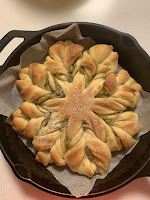Saving money and Eating healthy during a pandemic
While the global economic is alarmingly disrupted by
COVID-19, the suspended factories and businesses leave people jobless,
according to the UN’s labour body, 195 million jobs worldwide were wiped out. Such
unforeseen circumstances remain a long-term struggle.
Ever since schools are closed, kids start doing distance
learning, then the state of emergency is in place, our family rarely go out for
meals, home cooking for every single meal is the only solution to keep
ourselves safe but it drives me crazy at the beginning, food preparing, cooking
then washing repeatedly for sure are not fun. More family times mean we spend
more time to talk about different aspects of lives, we watch the news together
and lecture the kids how lucky they were that Daddy has a secure job.
On the other hand, the news reported that the Italian and
French have gained weight around 2-2.5kg during the 2-month lockdown. Totally
understandable. Lack of exercise is the cause.
As a full-time mother, I truly take the responsibility to safeguard
the health of my family. How to prepare low budget meals while control weight
gain and eat healthy? (Of course, the weight gain part does not imply on the
kids as they are growing, if there are concerns over the rate of kids’ weight
gain, the growth chart is a very helpful tool.)
Here are a few tips:
1.
Plant-based protein – Consider getting your
protein from plants, like soybean and beans more often. They cost less than
meat and have very low-fat content (using healthy cooking methods). Try
replacing 50% of meat intake with plant-based, high proteins food.
2. Canned foods – Some canned foods are not
necessarily bad for health such as tuna, baked beans, kernel corn, tomato, mushroom,
peas etc. Check the nutritional label and ingredients to make sure there is no
added salt and sugar.
3. Frozen veggies – Frozen veggies cost much lesser
than the fresh veggies, and in fact they do not differ significantly from fresh
veggies in terms of nutritional value. They are usually frozen within hours of
being picked, and when thawed, they are very close to fresh in taste and
texture.
4. Explore healthy recipes – Get the basic ingredients
from the supermarket (if you could find flour and yeast) and have fun cooking! You
will be surprised how economic it is to make commercial food ranging from Japanese
fluffy pancakes, pizza crust to Chinese steamed buns at home!
5. Go grocery shopping on a full stomach – Never go
shopping with an empty stomach. People tend to crave for high-calorie food when
they are hungry, resulting in excessive buying, especially the junk food. Write
a list of food that you need and shop from it, get a basket rather than a cart
at the supermarket.
6. Behavioral modification – this is a huge topic,
there are so many ways to control your eating habit to avoid over consumption.
a.
Drink 1 cup of water before each meal
b.
Use smaller plates / bowls / glasses at meals
c.
Eat slowly and drink water between each bite
d.
Only eat at a designated area eg. Dining table,
kitchen island
e.
Keep tempting food out of sight
f.
Weigh yourself once a week, weight can fluctuate
a lot in a day
Last but not least, remember to exercise regularly, stretching, yoga,
HIIT, you name it, there are tons of videos on youtube!





















